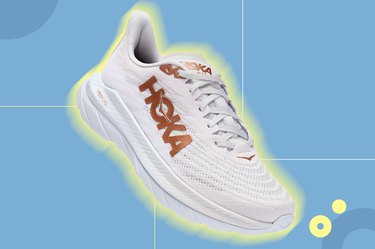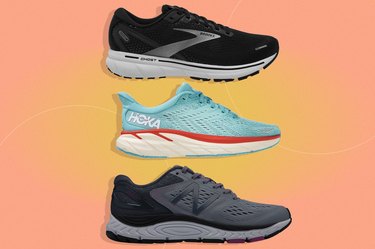If I could design a running shoe in a lab with access to all the intricate foams and pristine cushioning, I'd make something like the Hoka Mach 5.
Hoka shoes have historically been specialized for the sole purpose of distance running. After all, the brand gained popularity from the ultra running scene where the need to have max cushioning at a light weight was valued above all.
Video of the Day
Video of the Day
But the Mach 5 represents a groundbreaking moment of sorts for the brand because it's a shoe that feels just as apt to be used for plyometric exercises in the gym as it does to be your go-to shoe for long runs.
And while I do love this shoe on longer runs, I also want something that won't feel clunky when rattling off 200-meter repeats on the track. (Because student loans exist, I can't be breaking the bank on different types of shoes every month!) The Hoka Mach 5 fits the bill perfectly.
If my overly specific, running-shoe-obsessed self isn't convincing enough, you can look to the fact that when I brought my partner to a running shoe store and had her try on a litany of models from leading brands, she opted for the Machs herself. She doesn't log as many miles as I do, but the cushioning, weight and responsiveness of the shoe really sold her.
A Quick Language Note
We make deliberate choices about the language we use, but most manufacturers, like Hoka, market running sneakers to women and men. The main differences between most women's and men's shoes are width and size. In some cases, men's shoes are built to support greater weights, so people with larger bodies may want to try men's versions, while people with smaller bodies may prefer women's versions.
Features and Functionality
Over the course of my running career, I've injured just about every single bone, joint and tendon from my hips down to my toes. Because of my achilles injuries, I require a shoe with a lower heel-to-toe drop (the difference in height between the heel and forefoot in a running shoe). The Mach 5 — and all Hoka shoes for that matter — have that, coming in at 5 millimeters.
Additionally, I need a shoe that will brace the impact of the many miles I still run because of a previously fractured foot and some hip flexor issues, and the Mach 5 is just as soft and cushy as extremely high-cushioned shoes, like the Brooks Gylcerin, despite being multiple ounces lighter in weight. (The Hoka Mach 5 is just a shade over 8 ounces for the men's version and closer to 7 ounces for the women's version.)
It's not just the streamlined construction of the shoe that makes it my favorite, it's the fact that the Hoka Mach 5 doesn't have a carbon fiber plate (or any type of plate) running through the midsole, yet it feels as bouncy and responsive as just about any shoe I've ever worn. Hoka credits the responsiveness to their patented PROFLY foam that is featured in some of their other carbon-plated racing shoes, like the Rocket and Carbon-X.
However, those two models from the brand — and most other shoes that feel as light weight and responsive as the Mach 5 — normally are quite stiff and abrasive feeling under the foot.
That couldn't be further from the truth with the Mach 5. Hoka has found a way to strike a middle ground of softness and responsiveness that's nothing short of extraordinary. You'll feel like you can toe-off as quickly as you might want to in a racing flat, but be as protected from the ground as you'd be if you strapped a luxurious pillow to the bottom of your feet.
Related Reading
Get Your Perfect Pair of Hoka Mach 5 Running Shoes
The Hoka Mach 5 comes in five different colors. The men's version comes in sizes 7 to 14, and the women's version comes in sizes 5 to 11. The Mach 5 is available in wider widths as well.
The Mach 5 comes in at $140, putting it on the lower end of the price spectrum for specialty running shoes.
Ready to start logging soft, cushioned miles? Gear up with this perfect pair of running shoes.


